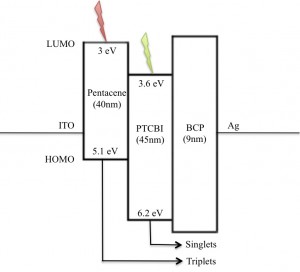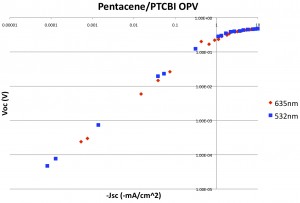Effect of Electron Spin on OPV Recombination
- Category: Energy, Optics & Photonics
- Tags: Jason Sussman, Marc Baldo
Organic photovoltaics (OPVs) are promising low-cost solar cells: they can be stacked in multi-junctions, and they are compatible with roll-to-roll processing. But as a solar cell’s installation costs are proportional to the area it covers, OPVs’ low efficiencies presently bar their widespread adoption. A significant source of loss in OPVs is the recombination of charges at the donor-acceptor interface: excited electrons combine with holes, returning the system to its ground state, rather than powering an external load. We therefore need to reduce the recombination rates in organic photovoltaics. We consider doing so by taking advantage of spin-disallowed transitions.
Excited states in OPVs come in two flavors of spin: singlets and triplets. Since the ground state is almost always a singlet, quantum mechanical rules prevent triplet excited states from relaxing, so triplets have longer lifetimes—i.e., lower recombination rates. In the absence of spin mixing processes, an OPV that produces electron-hole pairs in the triplet state should be more efficient than an OPV that produces singlets.
To prepare excited states in either the singlet or triplet state, we made a heterojunction solar cell with PTCBI (which produces singlets when excited) and pentacene (which produces triplets when excited [1] ). The spectral dependence of optical absorption in the two materials allows us to produce mostly triplets or singlets by exciting the device with 635-nm or 532-nm light, respectively. At room temperature the two show the same behavior; we are now examining the devices at much lower temperatures and under a magnetic field, where the mixing rate between the two states may be low enough to reveal the difference between the two.
- Figure 1: Energy level schematic for the organic heterojunction photovoltaic device. When excited, pentacene produces triplets; PTCBI produces singlets. We expect to see a difference in device performance according to which of the two we excite. Energy levels from [2] .
- Figure 2: Open-circuit voltage versus short-circuit current. Short-circuit current is a proxy for how many excitons are being created, while open-circuit voltage is a proxy for how many of those excitons recombine, so we would expect that the relationship between the two would be different for a 635-nm excitation (mainly triplets) versus a 532-nm excitation (mainly singlets). We see no difference at room temperature.
- J. Lee, P. Jadhav, and M. A. Baldo, “High efficiency organic multilayer photodetectors based on singlet exciton fission,” Appl. Phys. Lett., vol. 95, p. 033301, July 2009. [↩]
- J. Hwang, A. Wan, and A. Kahn, “Energetics of metal-organic interfaces: New experiments and assessment of the field,” Mater. Sci. Eng. R, vol. 64, pp. 1–31, Mar. 2009. [↩]

